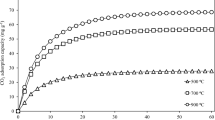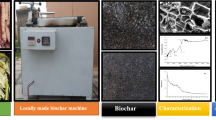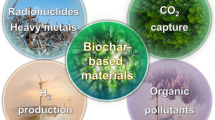Abstract
Biogas is mainly composed of methane (CH4) and carbon dioxide (CO2) with trace amounts of hydrogen sulfide (H2S), of which CO2 and H2S are impurities. Scrubbing of these two impurities are crucial for purification and upgradation of biogas, which would simultaneously also increase the calorific value of the treated biogas and address the issue of corrosion. Several studies have used expensive and environmentally harmful chemicals for the purification of biogas. This study reports a simple biogas purification system that utilizes biomass biochar and biochar–clay composites to remove CO2 and H2S from biogas by the process of adsorption. The biomass biochar could enrich the methane content of raw biogas from 59.7 to 84.6%, which shows the potentiality and applicability of biomass biochar for the removal of CO2 and H2S from biogas. This simultaneously enhanced the calorific value of the biogas and retarded the corrosiveness due to H2S. The study also indicated that CO2 adsorption by biomass biochar and biochar–clay composite is transient and has to be reloaded after saturation. Biochar and clay have the added advantage of being environment friendly and require no treatment for disposal. Observed results indicated that similar degree of enrichment, compared to commonly used chemical, could be achieved by application of biomass biochar and biochar–clay at a much lesser cost.
Access provided by Autonomous University of Puebla. Download conference paper PDF
Similar content being viewed by others
Keywords
1 Introduction
Rising concern about the environment, rapid depletion of fossil fuels and new environmental regulation has encouraged the search for new environmentally compatible materials obtained from natural resources [1, 2]. Thus, various forms of renewable energy such as solar, wind, tidal, wave, and biomass are getting attention worldwide during the last few decades. Harnessing energy from biomass is gaining popularity in developing countries due to the high availability of biomass and bio-waste. Biomass is an organic matter, which is available on a renewable basis and includes all plants and plant-derived materials. Lignocellulosic biomasses are abundantly available throughout the world and are recognized as a potential feed material for different applications like land filling, biogas, and biofuel productions [3, 4].
Biogas is a combustible mixture of gases produced from anaerobic digestion of organic matter by a community of microbial consortia. The digestion process takes place through various reactions and interactions among the methanogens and substrates fed into the digester [5, 6]. The biogas composition greatly depends on the type of feed materials, temperature, pressure, and pH inside the reaction digester [7]. The anaerobic digestion process generally comprises of four steps—hydrolysis, acidogenesis, acetogenesis, and methanogenesis [8]. Biogas is typically a mixture of 45–60% methane (CH4), 40–55% carbon dioxide (CO2), and a trace amount of other gases like nitrogen (N2), hydrogen (H2), and hydrogen sulfide (H2S) [9, 10]. The methane in biogas is a high-valued source of energy, while the other gases are impurities that cause major impediments to the commercial use of biogas [11]. CO2 has zero energy yield through combustion and greatly reduces the heating value due to its high concentration per volume of biogas. Thus, removal of carbon dioxide from biogas will enhance the fuel efficiency which could serve as a source of immense energy that can be used effectively for different purposes like cooking, lighting [12], vehicle fuel, and power generation [13]. A variety of processes are being used for removing carbon dioxide and hydrogen sulfide from natural gas and biogas in petrochemical and renewable industries. Several basic mechanisms are involved to achieve selective separation of gas constituents. These may include physical or chemical absorption, adsorption on a solid surface, membrane separation, and cryogenic separation [14].
Physical absorption of biogas is a simple and one of the cheapest methods to remove CO2 and H2S simultaneously. It uses water as the scrubbing agent, but the only limitation is that it requires high pressure and a lot of water for this process which makes it impractical for areas with water scarcity. However, from chemical absorption process, it was seen that chemical absorbents are more efficient in low pressure, but the only limitation is that the regeneration of the solvents requires relatively high energy input and also chemicals are not eco-friendly. Membrane separation and cryogenic separation give high purity, but they are economically not viable for pilot plant as it consumes relatively more electricity per unit of gas production [14, 15]. Chemical adsorption on solid surface gives economy in production with comparatively high purity. It has good moisture removal capacities and simple in design.
Hence, in this context, this work proposes the use of biomass biochar and biochar–clay composite material as scrubbing agent for CO2 removal targeting the rural households of the northeastern region of India. The scrubbing materials used here are anticipated to be beneficial over other conventional chemicals because the source material is abundantly available, has almost zero production cost, process of preparation is easy, and can be easily adopted in rural areas.
2 Materials and Methods
2.1 Materials
2.1.1 Biomass Collection and Processing to Biochar
Solid waste banana peels were collected from canteens in the campus of IIT Guwahati. They were washed under tap water to make them free from any impurities and were kept in a hot air oven at 60 °C for 24 h for the removal of moisture. The dried materials were kept in a muffle furnace at 550 °C for 6 h to convert it to biochar.
2.1.2 Preparation of Biochar–Clay Composite
Clay was collected from a local pottery vendor which was combined with biomass in a 1:3 mass ratio to form a mixture. The mixture formed was kept in a muffle furnace at 550 °C for 6 h to form a powdered sample.
2.2 Characterization of Biomass Samples
2.2.1 Proximate Analysis
Proximate analysis was used for the calculation of moisture, volatile matter, ash, and fixed carbon content of the biomass. The procedure used for the estimation of moisture and ash content was adopted from the National Renewable Energy Laboratory (NREL) protocol. American Society for Testing and Materials (ASTM) D 271-48 was followed for volatile matter determination. Fixed carbon was determined by difference from summation of moisture, volatile matter, and ash content.
2.2.2 Field Emission Scanning Electron Microscopy (FESEM)
The surface morphology of each adsorbent was determined by FESEM (Make: Zeiss, Model: Sigma) photography.
2.2.3 Elemental Analysis
Energy-dispersive X-ray spectroscopy (EDX) (Make: Zeiss, Model: Sigma) was used to determine the elemental composition of the selected adsorbents. The biomass samples were converted completely into ash by heating in a muffle furnace at 550 ○C for 6 h and were kept in a desiccator to cool to room temperature. A spherical pellet of diameter 5 mm and height 1 mm was prepared with the help of a pelletizer for the analysis.
2.2.4 Gas Chromatography
Raw and biogas sample treated with adsorbents were collected in Tedlar® bags and immediately analyzed in a gas chromatograph (Thermo Scientific Trace GC Ultra Gas Chromatograph, USA) for the volume-percentage composition of biogas.
3 Results and Discussion
3.1 Proximate Analysis of Biomass Sample
The dried biomass samples were used for proximate analysis. Proximate analysis results show that the biomass samples contains 8.52% moisture, 76.43% volatile matter, 10.25% ash, and 4.80% fixed carbon.
3.2 FESEM Images of Biomass Biochar and Biochar–Clay Composite
The morphology of the biomass biochar and biochar–clay composite was determined by FESEM imaging. Figures 1 and 2 show the FESEM images at a magnification of 5.00 KX times. It can be observed from the micrograph that the porosity and the surface area of biomass biochar is comparatively higher than biochar–clay composite. The formation of the porous cylindrical structures is attributed to the formation and subsequent expulsion of volatile components [16]. However, in Fig. 2, the clay particles can be seen as small lumps. It is anticipated that the presence of porous structures in biomass biochar and biochar–clay composite facilitates adsorption of CO2 from biogas by chemical reactions within the pores as explained in Eqs. 1 and 2.
3.3 Elemental Analysis of Biomass Biochar and Biochar–Clay Composite (Wt%)
The elemental composition in biomass biochar and biochar–clay composite was determined with the help of energy-dispersive X-ray spectroscopy (EDX). The results are summarized in Table 1. The potassium content of biomass biochar (34.7 wt%) is found higher than biochar–clay composite (19.3 wt%). The potassium present in biomass biochar and biochar–clay composite is anticipated to react with the moisture present in biogas to form potassium hydroxide which in turn would help to adsorb CO2 and hence enrich the methane content in biogas [17]. The chemical reactions are as follows:
3.4 Purification of Biogas with Adsorbents
The biogas was collected from a 3 m3 Deenbandhu biogas plant located at AaoniatiSatra, North Guwahati, Assam. Cow dung was used as the only feed material in the biogas plant. The methane and carbon dioxide volume percentage of the raw biogas sample were found to be 59.7% and 40.3%, respectively. Biomass biochar and biochar–clay composite were used as adsorbents for the removal of CO2and H2S from biogas. When compared with the raw biogas sample (having a methane content of 59.7%), the biogas samples treated with biomass biochar and biochar–clay composite showed 84.6% and 77.3% methane content, respectively (Fig. 3). Moreover, the H2S level, which was 286 ppm in the raw biogas, decreased to 32 and 46 ppm when treated with biomass biochar and biochar–clay composite, respectively.
4 Conclusions
This work reports the synthesis, characterization, and application of biomass biochar and biochar–clay composite as CO2 and H2S scrubbers from biogas. The elemental characterization by EDX reveals that potassium is present in higher quantities as compared to the other elements. FESEM images supports the presence of pores in the structures of the adsorbents which facilitates adsorption of CO2 from biogas. The gas chromatography results also show that the adsorbents, biomass biochar and biochar–clay composite, could enrich the methane content of a raw biogas sample by 24.9% and 17.6%, respectively, which shows the potentiality and applicability of natural adsorbents for purification of biogas. Out of several methods of biogas purification, this method is found to be simple, low cost, environment friendly, and suitable method for enrichment of biogas in rural areas. Further experiment needs to be done to enable complete removal of CO2 from raw biogas and to increase their efficiency.
References
A. Demirbas, Use of algae as biofuel sources. Energy Convers. Manage. 5(1), 2738–2749 (2010)
FM. Pelissari, AS.PauloJose´do, FC. Menegalli, Isolation and characterization of cellulose nanofibers from banana peels,Cellulose, 2014, 21, pp. 417–432.
A.J. Borah, M. Agarwal, M. Poudyal, A. Goyal, V.S. Moholkar, Mechanistic investigation in ultrasound induced enhancement of enzymatic hydrolysis of invasive biomass species. Biores. Technol. 213, 342–349 (2016)
A.J. Borah, S. Singh, A. Goyal, V.S. Moholkar, An assessment of invasive weeds as multiple feedstocks for biofuels production. RSC Adv. 6, 47151–47163 (2016)
P. Mahanta, A. Dewan, U.K. Saha, P. Kalita, B. Buragohain, Biogas digester: a discussion on factors affecting biogas production and field investigation of a novel duplex digester. J. Solar Soc. India SESI J. 15(2), 1–12 (2005)
I. Diaz, S.I. Perez, E.M. Ferrero, M. Fdz-Polanco, Effect of oxygen dosing point and mixing on the microaerobic removal of hydrogen sulphide in sludge digesters. Biores. Technol. 102(4), 3768–3775 (2011)
S. Rasi, A. Veijanen, J. Rintala, Trace compounds of biogas from different biogas production plants. Energy 32, 1375–1380 (2007)
M. Gerardi, The Microbiology of Anaerobic Digesters, Waste Water Microbiology Series (John Wiley & Sons, Inc., United States of America, 2003), p. 7
G. Mann, M. Schlegel, R. Schumann, A. Sakalauskas, Biogas-conditioning with microalgae. Agron. Res. 7(1), 33–38 (2009)
A.B. Karki, J.N. Shrestha, S. Bajgain, Biogas: as renewable source of energy in Nepal, theory and development. BSP-Nepal, 1–189 (2005)
N. Abatzoglou, S. Boivin, A review of biogas purification processes. Biofuels Bioprod. Biorefin. 3(1), 42–71 (2008)
N.H.S. Ray, M.K. Mohanty, R.C. Mohanty, Biogas compression and storage system for cooking applications in rural Households. Int. J. Renew. Energy Res. 6(2), 593–598 (2016)
Q. Sun, H. Li, J. Yan, L. Liu, Z. Yu, X. Yu, Selection of appropriate biogas upgrading technology-a review of biogas cleaning, upgrading and utilization. Renew. Sustain. Energy Rev. 51, 521–532 (2015)
F. Osorio, J.C. Torres, Biogas purification from anaerobic digestion in a wastewater treatment plant for biofuel production. Renew. Energy 34, 2164–2171 (2009)
M. Hagen, E. Polman, Adding gas from biomass to the gas grid, in Final Report Submitted to Danish Gas Agency (2001)
R. Yin, R. Liu, Y. Mei, W. Fei, X. Sun, Characterization of bio-oil and bio-char obtained from sweet sorghum bagasse fast pyrolysis with fractional condensers. Fuel 112, 96–104 (2013)
M. Fernández-Delgado, Juárez, P. Mostbauer, A. Knapp, W. Müller, S. Tertsch, A. Bockreis, H. Insam, Biogas purification with biomass ash. Waste Manage. 71, 224–232 (2018)
Acknowledgements
The authors gratefully acknowledge the financial support of the Ministry of New and Renewable Energy, Government of India, for the above project (256/3/2017-BIOGAS).
Author information
Authors and Affiliations
Corresponding author
Editor information
Editors and Affiliations
Rights and permissions
Copyright information
© 2021 The Editor(s) (if applicable) and The Author(s), under exclusive license to Springer Nature Singapore Pte Ltd.
About this paper
Cite this paper
Bora, D., Barbora, L., Mahanta, P. (2021). Purification of Biogas for Methane Enrichment Using Biomass Biochar and Biochar–Clay Composite. In: Pandey, K., Misra, R., Patowari, P., Dixit, U. (eds) Recent Advances in Mechanical Engineering. Lecture Notes in Mechanical Engineering. Springer, Singapore. https://doi.org/10.1007/978-981-15-7711-6_57
Download citation
DOI: https://doi.org/10.1007/978-981-15-7711-6_57
Published:
Publisher Name: Springer, Singapore
Print ISBN: 978-981-15-7710-9
Online ISBN: 978-981-15-7711-6
eBook Packages: EngineeringEngineering (R0)







